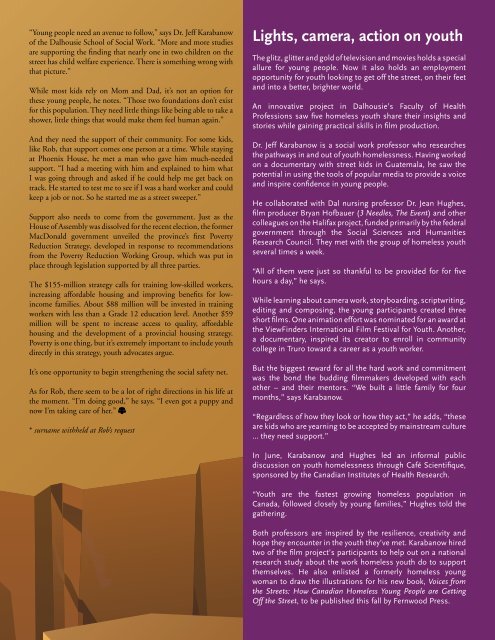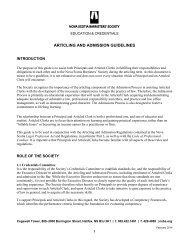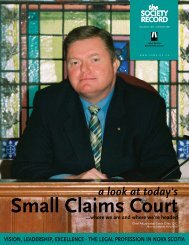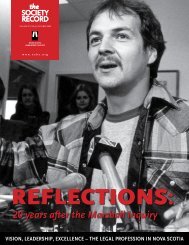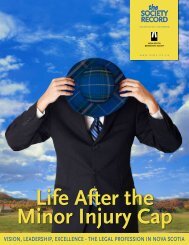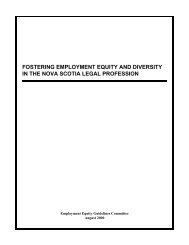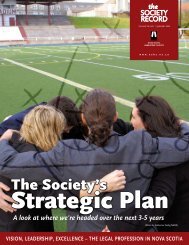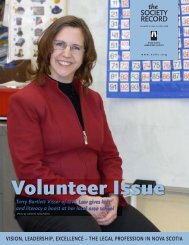SR Vol 27 No 3, July 2009 - Nova Scotia Barristers' Society
SR Vol 27 No 3, July 2009 - Nova Scotia Barristers' Society
SR Vol 27 No 3, July 2009 - Nova Scotia Barristers' Society
Create successful ePaper yourself
Turn your PDF publications into a flip-book with our unique Google optimized e-Paper software.
“Young people need an avenue to follow,” says Dr. Jeff Karabanow<br />
of the Dalhousie School of Social Work. “More and more studies<br />
are supporting the finding that nearly one in two children on the<br />
street has child welfare experience. There is something wrong with<br />
that picture.”<br />
While most kids rely on Mom and Dad, it’s not an option for<br />
these young people, he notes. “Those two foundations don’t exist<br />
for this population. They need little things like being able to take a<br />
shower, little things that would make them feel human again.”<br />
And they need the support of their community. For some kids,<br />
like Rob, that support comes one person at a time. While staying<br />
at Phoenix House, he met a man who gave him much-needed<br />
support. “I had a meeting with him and explained to him what<br />
I was going through and asked if he could help me get back on<br />
track. He started to test me to see if I was a hard worker and could<br />
keep a job or not. So he started me as a street sweeper.”<br />
Support also needs to come from the government. Just as the<br />
House of Assembly was dissolved for the recent election, the former<br />
MacDonald government unveiled the province’s first Poverty<br />
Reduction Strategy, developed in response to recommendations<br />
from the Poverty Reduction Working Group, which was put in<br />
place through legislation supported by all three parties.<br />
The $155-million strategy calls for training low-skilled workers,<br />
increasing affordable housing and improving benefits for lowincome<br />
families. About $88 million will be invested in training<br />
workers with less than a Grade 12 education level. Another $59<br />
million will be spent to increase access to quality, affordable<br />
housing and the development of a provincial housing strategy.<br />
Poverty is one thing, but it’s extremely important to include youth<br />
directly in this strategy, youth advocates argue.<br />
It’s one opportunity to begin strengthening the social safety net.<br />
As for Rob, there seem to be a lot of right directions in his life at<br />
the moment. “I’m doing good,” he says. “I even got a puppy and<br />
now I’m taking care of her.”<br />
* surname withheld at Rob’s request<br />
Lights, camera, action on youth<br />
The glitz, glitter and gold of television and movies holds a special<br />
allure for young people. <strong>No</strong>w it also holds an employment<br />
opportunity for youth looking to get off the street, on their feet<br />
and into a better, brighter world.<br />
An innovative project in Dalhousie’s Faculty of Health<br />
Professions saw five homeless youth share their insights and<br />
stories while gaining practical skills in film production.<br />
Dr. Jeff Karabanow is a social work professor who researches<br />
the pathways in and out of youth homelessness. Having worked<br />
on a documentary with street kids in Guatemala, he saw the<br />
potential in using the tools of popular media to provide a voice<br />
and inspire confidence in young people.<br />
He collaborated with Dal nursing professor Dr. Jean Hughes,<br />
film producer Bryan Hofbauer (3 Needles, The Event) and other<br />
colleagues on the Halifax project, funded primarily by the federal<br />
government through the Social Sciences and Humanities<br />
Research Council. They met with the group of homeless youth<br />
several times a week.<br />
“All of them were just so thankful to be provided for for five<br />
hours a day,” he says.<br />
While learning about camera work, storyboarding, scriptwriting,<br />
editing and composing, the young participants created three<br />
short films. One animation effort was nominated for an award at<br />
the ViewFinders International Film Festival for Youth. Another,<br />
a documentary, inspired its creator to enroll in community<br />
college in Truro toward a career as a youth worker.<br />
But the biggest reward for all the hard work and commitment<br />
was the bond the budding filmmakers developed with each<br />
other – and their mentors. “We built a little family for four<br />
months,” says Karabanow.<br />
“Regardless of how they look or how they act,” he adds, “these<br />
are kids who are yearning to be accepted by mainstream culture<br />
… they need support.”<br />
In June, Karabanow and Hughes led an informal public<br />
discussion on youth homelessness through Café Scientifique,<br />
sponsored by the Canadian Institutes of Health Research.<br />
“Youth are the fastest growing homeless population in<br />
Canada, followed closely by young families,” Hughes told the<br />
gathering.<br />
Both professors are inspired by the resilience, creativity and<br />
hope they encounter in the youth they’ve met. Karabanow hired<br />
two of the film project’s participants to help out on a national<br />
research study about the work homeless youth do to support<br />
themselves. He also enlisted a formerly homeless young<br />
woman to draw the illustrations for his new book, Voices from<br />
the Streets: How Canadian Homeless Young People are Getting<br />
Off the Street, to be published this fall by Fernwood Press.<br />
<strong>July</strong> <strong>2009</strong> 19


